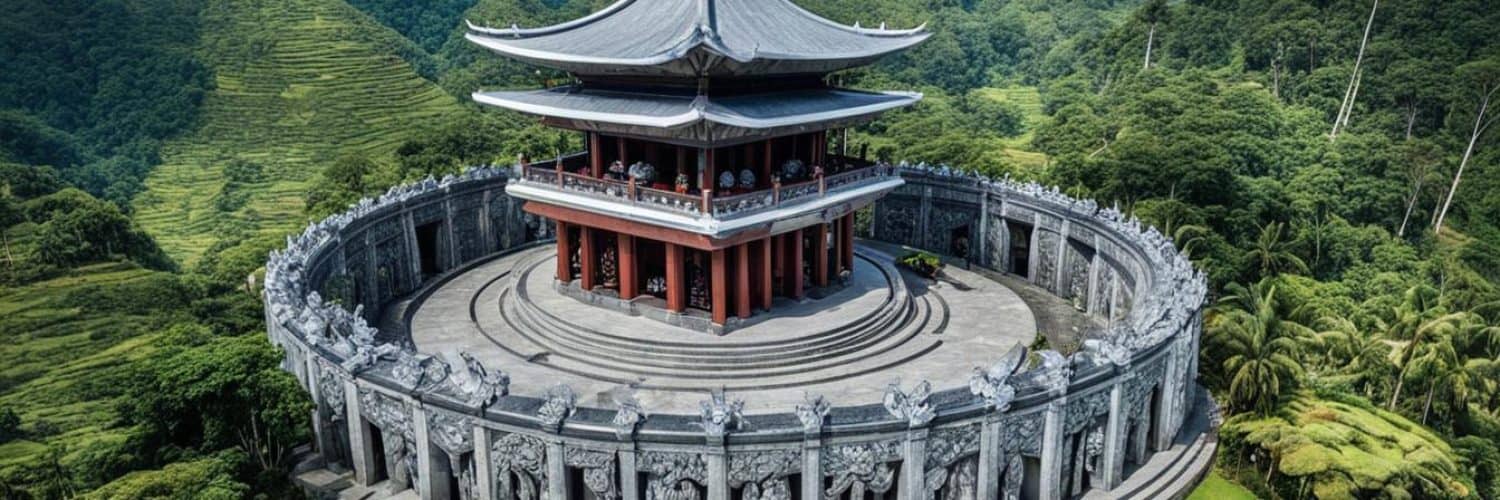The Kiangan War Memorial Shrine in Ifugao province is a significant Philippine war memorial that pays tribute to the brave Filipinos and Americans who sacrificed their lives during World War II. This concrete pyramid-type structure, resembling an oversized Ifugao native house, stands as a powerful symbol of heroism and resilience.
Key Takeaways:
- The Kiangan War Memorial Shrine in Ifugao is a Philippine war memorial honoring the bravery of Filipinos and Americans during World War II.
- This concrete pyramid-type structure is a symbol of heroism and resilience.
- The shrine stands as a powerful tribute to the sacrifices made by allies and serves as a reminder of the significance of Ifugao’s role in the war.
- Visiting the Kiangan War Memorial Shrine offers an opportunity to learn about Ifugao heritage and the impact of World War II on the region.
- The annual commemoration activities held at the shrine ensure that the memory of the war heroes lives on and reminds us of the importance of preserving our shared history.
History of the Kiangan War Memorial Shrine
The Kiangan War Memorial Shrine stands as a powerful historical monument, preserving the rich heritage of Ifugao and commemorating the sacrifices made during World War II. Built on the site where the Japanese Imperial Forces surrendered in 1945, this shrine serves as a solemn reminder of the past and a symbol of peace and remembrance.
Funded by the Philippine Tourism Authority and now under the administration of the Philippine Veterans Affairs Office, the Kiangan War Memorial Shrine holds immense significance in the history of the Philippines. It represents a tangible connection to the events that unfolded during the war and pays tribute to the brave men and women who fought for their country’s freedom.
With its unique architectural design, the shrine serves as a beacon, guiding visitors through the annals of time and offering glimpses into the courage and sacrifice of the past. Its structure, reminiscent of an oversized Ifugao native house, stands as a testament to the enduring spirit and resilience of the Filipino and American soldiers.
The Kiangan War Memorial Shrine holds a special place in Ifugao heritage, honoring the collective memory of the local community and preserving its historical identity. The shrine’s significance extends beyond its architectural beauty, serving as a catalyst for reflection and a catalyst for dialogue about the impact of war on the region and the need for lasting peace.
“The Kiangan War Memorial Shrine stands as a timeless testament to the valor and sacrifice of those who fought during World War II. It reminds us of the importance of preserving our collective history and instills a sense of gratitude for the freedom we enjoy today.”
The Historical Significance of the Kiangan War Memorial Shrine
The Kiangan War Memorial Shrine holds immense historical significance as the site where one of the most critical events of World War II took place. It marks the end of the Japanese occupation in the Philippines and serves as a poignant reminder of the resilience and determination of the Filipino people.
| Historical Significance | Ifugao Heritage |
|---|---|
| The surrender of the Japanese Imperial Forces marked a turning point in the war, leading the way to the liberation of the Philippines. | The shrine represents an important part of Ifugao heritage, showcasing the rich cultural and historical legacy of the region. |
| The memorial stands as a testament to the heroism and sacrifice of the Filipino and American soldiers who fought to defend their homeland. | Ifugao’s cultural traditions and ancestral heritage find resonance within the walls of the shrine, connecting past and present generations. |
| The Kiangan War Memorial Shrine serves as a symbol of peace and remembrance, fostering a deeper understanding of the consequences of war. | By preserving Ifugao heritage through the shrine, the community strengthens its cultural identity and fosters a sense of pride. |
The Kiangan War Memorial Shrine, with its historical significance and representation of Ifugao heritage, attracts visitors from around the world. It offers a unique opportunity to explore the complexities of the past while instilling a sense of awe and reverence for the sacrifices made during World War II.
Location and Access to the Shrine
The Kiangan War Memorial Shrine, a tourist attraction in Ifugao and a cultural landmark, is situated in Kiangan, Ifugao Province, located on the island of Luzon in the Philippines. This significant memorial can be easily reached by buses from Manila, with direct trips to the capital town of Ifugao, Lagawe. From Lagawe, visitors can conveniently travel to the shrine by jeeps, as it is just a short distance away. The shrine’s strategic location offers a breathtaking view of the surrounding barangays (villages) and the capital town, providing a tranquil and picturesque setting for visitors.
Plan your trip to the Kiangan War Memorial Shrine and explore this historical site that pays homage to the bravery and sacrifices made during World War II.
Importance of Remembering the War
The Kiangan War Memorial Shrine holds an annual commemoration every September 2nd to remember the events that took place on that day in 1945. This event is crucial in recognizing the significance of Ifugao’s role in the end of World War II. It serves as a solemn reminder of the bravery and sacrifice of the soldiers and civilians who fought and died during the war. By remembering the war and paying tribute to those who contributed to the victory, we honor their memory and keep their legacy alive for future generations.
| Reasons to Remember the War | Explanation |
|---|---|
| Preserving Ifugao History | The annual commemoration at the Kiangan War Memorial Shrine allows us to preserve and pass down the historical significance of Ifugao’s involvement in World War II. It helps us understand the impact of the war on the local community and its enduring legacy. |
| Gratitude and Respect | Remembering the war is a way to express gratitude and respect to the soldiers and civilians who sacrificed their lives for the cause of freedom. Their courage and selflessness deserve our eternal appreciation. |
| Education and Awareness | The commemoration events held at the shrine provide an opportunity to educate younger generations about the war and its consequences. It serves as a reminder to value peace and understanding to prevent similar conflicts in the future. |
| Honoring the Fallen | By commemorating the war, we pay tribute to the fallen heroes who made the ultimate sacrifice. Their sacrifice should never be forgotten, and their names should live on in our hearts and memories. |
“The willingness of America’s veterans to sacrifice for our country has earned them our lasting gratitude.”
As we gather at the Kiangan War Memorial Shrine every year, we come together as a community to honor and remember. We reflect on the past, acknowledge the hardships endured, and look towards a future of peace and unity. By preserving the memories of the war, we ensure that the lessons learned are never forgotten, and history never repeats itself.
Symbolism and Design of the Shrine
The Kiangan War Memorial Shrine stands as a remarkable architectural testament, combining symbolism and design to honor the heroic acts of Filipino and American soldiers during World War II. Its unique concrete pyramid structure reflects an enlarged Ifugao native house, imbued with profound meaning and cultural significance.
“The shrine’s symbolism is a powerful representation of peace and resilience, showcasing the rich indigenous culture of the Ifugao people.”
The shrine’s design pays homage to the Ifugao heritage, highlighting the strength and resilience displayed by local communities amidst the turmoil of war. It serves as a symbol of peace, inspiring visitors with its striking architectural features and historical significance.
Architectural Features
The Kiangan War Memorial Shrine stands proudly, attracting tourists and visitors with its captivating architectural features:
- A Concrete Pyramid: The shrine’s pyramid-shaped structure signifies strength and stability, while its verticality evokes a sense of elevation and reverence.
- Native House Influence: The design draws inspiration from the traditional Ifugao native house, reflecting the local culture and connecting the memorial to the region’s rich heritage.
- Scenic Location: Nestled amidst the picturesque landscape of Kiangan, the shrine offers breathtaking views, creating a serene and peaceful ambiance as visitors engage in reflection and remembrance.
With its powerful symbolism and compelling design, the Kiangan War Memorial Shrine stands as a testament to the enduring spirit of the Filipino and American soldiers who fought for freedom. It serves as a poignant reminder of the sacrifices made during World War II and the importance of embracing peace and cultural heritage.
Importance of Ifugao-Japan Relations
The visit of Japanese Emperor Akihito to the Kiangan War Memorial Shrine highlights the significance of Philippines-Japan diplomatic relations. Both countries have been actively strengthening their economic and defense ties, particularly in response to the assertive actions of China in the region.
The Kiangan War Memorial Shrine serves as a symbol of peace and reconciliation between the Philippines and Japan. It stands as a testament to the shared history and the mutual understanding between the two nations.
Commemoration Activities at the Shrine
The Kiangan War Memorial Shrine is not only a static monument but also a vibrant space where various commemoration activities take place annually on September 2nd. These activities serve as an annual celebration and a heartfelt tribute to the brave war heroes who sacrificed their lives during World War II.
During the commemoration event, the shrine is adorned with wreaths as a symbol of honor and gratitude. Wreath-laying ceremonies are held, allowing locals, visitors, and descendants of war veterans to pay their respects and remember the sacrifices made by these courageous individuals.
“We gather here to commemorate the lives of our fallen heroes, to keep their memory alive, and to express our deep gratitude for their sacrifices. Through these wreaths, we honor their bravery and unwavering commitment to defend our freedom.”
The commemoration activities also include speeches given by dignitaries and individuals who share personal connections to the war. These speeches serve as a reminder of the significance of the shrine and the enduring legacy of the war heroes. They inspire visitors to reflect on the past, appreciate the present, and work towards a peaceful future.
Cultural performances are an integral part of the commemoration activities, showcasing the rich heritage and traditions of the Ifugao community. These performances celebrate the Ifugao culture and serve as an expression of gratitude towards the war heroes. They create a vibrant atmosphere filled with music, dance, and storytelling, further deepening the connection between the present generation and the heroes of the past.
The Kiangan War Memorial Shrine, through its annual commemoration activities, acts as a bridge between history and the present. It ensures that the sacrifices of the war heroes are never forgotten and serves as a reminder of the enduring values of courage, resilience, and sacrifice.
| Commemoration Activities | Description |
|---|---|
| Wreath-laying Ceremonies | Participants pay tribute to the war heroes by laying wreaths at the shrine. |
| Speeches | Dignitaries and individuals share their thoughts and insights, honoring the sacrifices made. |
| Cultural Performances | Music, dance, and storytelling showcasing the rich Ifugao culture and traditions. |
Contributions of the Community
The Kiangan War Memorial Shrine is not just a monument built by authorities; it is a living testament to the dedication and involvement of the local community. The stakeholders of Kiangan take pride in the shrine and actively participate in its upkeep and maintenance. Their “sweat equity” goes beyond mere financial contributions, as they invest their time, effort, and resources to ensure that the memorial remains a symbol of their shared history and a place of remembrance.
The community’s involvement in the Kiangan War Memorial Shrine is evident in their organization of annual commemoration activities. These events bring together locals, visitors, and descendants of war veterans to pay tribute to the heroes who sacrificed their lives during World War II. The community’s commitment to preserving the memory of the war and honoring the fallen soldiers ensures that the shrine remains an important cultural landmark for generations to come.
Future Plans for the Shrine
As we continue to honor the sacrifices made during World War II, there have been significant policy recommendations to recognize the Surrender of General Yamashita in Kiangan as a national historical event. Alongside this, there is a proposal to establish a national observance of this event, amplifying the attention on the Kiangan War Memorial Shrine and its historical significance.
The intention behind these policy recommendations is to preserve the memory of the events that took place and to promote peace and justice. Designating the Surrender of General Yamashita in Kiangan as a national historical event would reinforce the importance of this significant moment in history and ensure that it remains a prominent part of our national narrative. With a national observance, we can pay tribute to the bravery and sacrifice of those involved while educating future generations about the lessons learned from this dark period.
The Kiangan War Memorial Shrine is not only a testament to the past but also a symbol of hope for the future. By implementing these policy recommendations, we can raise awareness about the historical significance of the shrine and encourage a sense of national pride and unity among Filipinos.
Together, we can create a lasting legacy that not only preserves the memory of the brave individuals who fought during World War II but also inspires present and future generations to strive for a peaceful and just society.
Key Policy Recommendations:
- Elevate the Surrender of General Yamashita in Kiangan as a national historical event
- Establish a national observance to commemorate the surrender
- Raise awareness about the historical significance of the Kiangan War Memorial Shrine
- Encourage educational initiatives to teach the lessons of World War II and promote peace and justice
Visit to Other Battle Sites
During his visit to the Philippines, Emperor Akihito plans to pay his respects at the Caliraya shrine, a sacred site dedicated to Japanese casualties of the war. Located in the village of Caliraya, south of Manila, the shrine holds historical significance as the site of the last battles fought in the Philippines during World War II. The Emperor’s visit to this solemn place aims to promote healing, goodwill, and remembrance.
The Significance of Caliraya Shrine
Caliraya Shrine serves as a poignant reminder of the sacrifices made by Japanese soldiers during the war. It stands as a testament to the enduring impact of World War II on the region, and its historical value extends beyond its role as a memorial. The shrine attracts visitors from all over the world who come to reflect on the history and pay homage to those who gave their lives.
Preserving Ifugao History
Ifugao province holds a rich history that should be preserved and honored. The visit to Caliraya shrine highlights the importance of recognizing and respecting the historical significance of this region. By fostering cultural understanding and appreciation, this visit contributes to the preservation of Ifugao history for future generations. It serves as a reminder of the tremendous sacrifices made during the war and the importance of peace and reconciliation.
Relevance of the Shrine Today
The Kiangan War Memorial Shrine holds great significance in the present-day Japan-Philippines relationship and development assistance efforts. Japan’s commitment to Ifugao province is exemplified through various projects aimed at improving maternal health, infrastructure, and reforestation.
Through these development initiatives, Japan not only showcases its dedication to the well-being of the province and its people but also strengthens the bond between the two nations. The Kiangan War Memorial Shrine stands as a tangible reminder of the shared history between Japan and the Philippines and reinforces the importance of peace and cooperation.
“The Kiangan War Memorial Shrine serves as a symbol of the strong partnership between Japan and the Philippines today.”
As a testimony to the profound impact of collaboration, this shrine is an embodiment of the mutual respect and support that define the Japan-Philippines relationship. Its presence resonates with the local community and visitors alike, reminding all who see it of the enduring ties that have been forged.
The commitment of Japan to Ifugao and its development underscores the importance of nurturing diplomatic relationships that extend beyond economic and defense ties. By investing in initiatives that promote the well-being of the province, Japan demonstrates its dedication to sustainable development and partnerships grounded in historical understanding.
The Kiangan War Memorial Shrine not only pays homage to the past but also serves as a beacon of hope for a prosperous and harmonious future between Japan and the Philippines.
Conclusion
The Kiangan War Memorial Shrine in Ifugao is a profound testament to the heroism and sacrifices made during World War II. This historical monument serves as a symbol of peace, reconciliation, and cooperation between the Philippines and Japan. The annual commemoration activities held at the shrine ensure that the memory of the war heroes lives on, keeping alive the importance of preserving our shared history.
Visiting the Kiangan War Memorial Shrine offers a unique opportunity to delve into the rich heritage of Ifugao and gain a deeper understanding of the impact of World War II on the region. The shrine’s striking architecture and serene surroundings provide a poignant backdrop for reflection and remembrance.
As we pay homage to the brave individuals who fought and made sacrifices during the war, the Kiangan War Memorial Shrine serves as a powerful reminder of the significance of peace and unity. It stands as a testament to the enduring bond between the Philippines and Japan, highlighting the value of cooperation and friendship in building a better future.
FAQ
What is the Kiangan War Memorial Shrine?
The Kiangan War Memorial Shrine is a tribute to the Filipinos and Americans who sacrificed their lives during World War II. It is a concrete pyramid-type structure resembling an oversized Ifugao native house.
Where is the Kiangan War Memorial Shrine located?
The Kiangan War Memorial Shrine is located in Kiangan, Ifugao Province, in the island of Luzon, Philippines.
How can I access the shrine?
The shrine can be reached by taking buses from Manila to Lagawe, the capital town of Ifugao. From Lagawe, jeeps can be used to reach the shrine, which is just a short distance away.
Why is it important to remember the war?
Remembering the war and the sacrifices made honors the heroism and bravery displayed by the soldiers and civilians during World War II.
What is the symbolism behind the shrine’s design?
What is the significance of the shrine in the Philippines-Japan relationship?
The shrine serves as a symbol of peace and reconciliation between the two nations and highlights the strong partnership between Japan and the Philippines today.
What activities are held at the shrine?
The shrine hosts various commemoration activities every year on September 2nd, including wreath-laying ceremonies, speeches, and cultural performances.
How does the community contribute to the shrine’s maintenance?
The community of Kiangan plays a significant role in the upkeep and maintenance of the shrine, preserving it as a living memorial and organizing commemoration activities.
Are there any future plans for the shrine?
There have been policy recommendations to recognize the surrender of General Yamashita in Kiangan as a national historical event and to establish a national observance of this event.
Is there a plan to visit other battle sites?
During his visit to the Philippines, Emperor Akihito plans to visit a shrine for Japanese casualties of the war in Caliraya, a village south of Manila.
What is the relevance of the shrine today?
The shrine serves as a symbol of the strong partnership between Japan and the Philippines today, demonstrating the shared history and importance of peace and cooperation.
Conclusion
The Kiangan War Memorial Shrine in Ifugao is a significant historical monument that pays tribute to the heroism and sacrifices of World War II. It serves as a symbol of peace, remembrance, and cooperation between nations.


















Add comment